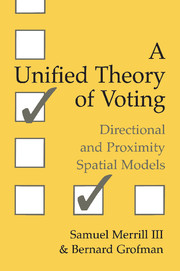Book contents
- Frontmatter
- Contents
- List of Tables and Figures
- Acknowledgments
- 1 Introduction
- Part I Models of Voter Behavior
- Part II Models of Party or Candidate Behavior and Strategy
- 8 Equilibrium Strategies for Two-Candidate Directional Spatial Models
- 9 Long-term Dynamics of Voter Choice and Party Strategy
- 10 Strategy and Equilibria in Multicandidate Elections
- 11 Strategy under Alternative Multicandidate Voting Procedures
- Postscript
- Appendices
- Glossary of Symbols
- References
- Index
10 - Strategy and Equilibria in Multicandidate Elections
Published online by Cambridge University Press: 04 December 2009
- Frontmatter
- Contents
- List of Tables and Figures
- Acknowledgments
- 1 Introduction
- Part I Models of Voter Behavior
- Part II Models of Party or Candidate Behavior and Strategy
- 8 Equilibrium Strategies for Two-Candidate Directional Spatial Models
- 9 Long-term Dynamics of Voter Choice and Party Strategy
- 10 Strategy and Equilibria in Multicandidate Elections
- 11 Strategy under Alternative Multicandidate Voting Procedures
- Postscript
- Appendices
- Glossary of Symbols
- References
- Index
Summary
We know what happens to people who stay in the middle of the road; they get run down.
Aneurin Bevan, Observer (December 9, 1953)Multicandidate Equilibria
In one dimension, two-candidate equilibrium strategies are convergent for the proximity model. In this chapter, we investigate the existence and nature of equilibria for three or more candidates. Under a proximity model – even for one dimension – no equilibria exist for three candidates (the two extreme candidates always have a unilateral incentive to move inward, but eventually the squeezed center candidate can benefit by leapfrogging; this cycle repeats with no end). In fact, for plurality-maximizing candidates, in one dimension, no equilibrium occurs for any fixed odd number of candidates three or higher. For four candidates, assuming a uniform distribution of voters, an equilibrium does occur, with two candidates located at the 25th percentile of the distribution and two at the 75th percentile. In any event, such an equilibrium is far from convergent at the median and is quite implausible empirically. It is an artifact of deterministic assumptions.
In Chapter 6 we introduced a probabilistic model of voter choice, fitting it first to data from a two-party electorate and then to data from a multicandidate electorate in Chapter 7. As we will see, a probabilistic model – even one based on proximity – can lead to a convergent multicandidate equilibrium, which extends to a multidimensional setting. If, however, a party ID component is added, i.e., vote choice is in part determined by partisan identification of the voters, a convergent equilibrium is obtained in two-party competition; but for three or more parties, the equilibrium is divergent, i.e., the parties settle on distinct optimal strategies.
- Type
- Chapter
- Information
- A Unified Theory of VotingDirectional and Proximity Spatial Models, pp. 144 - 157Publisher: Cambridge University PressPrint publication year: 1999
- 1
- Cited by



